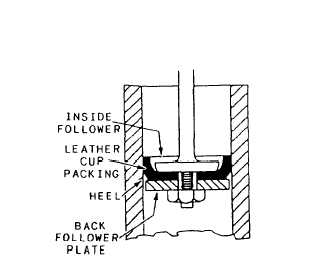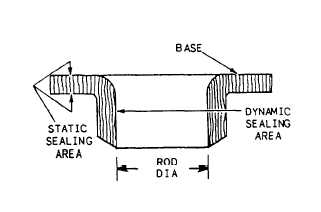Figure 7-20.–Cup packing.
seals. The flange
made of leather,
(sometimes called
fabric-reinforced
the hat) is
rubber, or
homogeneous rubber. Lip sealing occurs only on
the packing ID (fig. 7-21). Flange packings are
generally used only for rod seals when other
packings such as V-rings or U-seals cannot be
used.
DIRT EXCLUSION SEALS
(WIPERS AND SCRAPERS)
Dirt exclusion devices are essential if a
satisfactory life is to be obtained from most rod
seals. The smooth finished moving rod surface,
if not enclosed or protected by some sort of
covering, will accumulate a coating of dust or
abrasive material that will be dragged or carried
into the packing assembly area on the return rod
stroke. Exclusion devices called wipers or scrapers
are designed to remove this coating. While the
terms wiper and scraper are often used
interchangeably, it is useful to reserve scraper
Figure 7-21.—Typical flange packing cross section.
for metal lip-type devices that remove heavily
encrusted deposits of dirt or other abrasive
material that would merely deflect a softer lip and
be carried into the cylinder. Sometimes a rod will
have both a scraper and a wiper, the former to
remove heavy deposits and the latter to exclude
any dust particles that remain. Whenever metallic
scrapers are used with felt wipers in the same
groove, the felt wiper must not be compressed nor
restricted in any way that affects its function as
a lubricator. A wiper installed in a seal assembly
in a pneumatic application may remove too much
oil from the rod, requiring some method of
replacing the oil. A common remedy is to provide
a periodically oiled felt ring between the wiper
and the seal. Felt wipers provide lubrication
to extended operating rods, thus increasing
component wear life. These wipers are only used
to provide lubrication to parts.
Much longer life could be obtained from most
seals if proper attention were given to wipers and
scrapers. Often, wiper or scraper failure is not
noticed when a seal packing fails. As a result, only
the packing is replaced, and the same worn wiper
or scraper is reinstalled to destroy another
packing. Check the wiper or scraper condition
upon its removal. If the wiper is worn, dirty, or
embedded with metallic particles, replace it with
a new one. It is usually good practice to replace
the wiper every time you replace the seal and even
more frequently if the wiper is readily accessible
without component disassembly. If replacements
are not available, wash dirty wipers that are still
in good condition with suitable solvent and
reinstall them. Remember that a wiper or scraper
is deliberately installed as a sacrificial part
to protect and preserve the sealing packing.
Therefore, from a user’s standpoint, wipers and
scrapers should be inspected and replaced as
necessary.
STORAGE OF SEALS
Proper storage practices must be observed to
prevent deformation and deterioration of seals.
Most synthetic rubbers are not damaged by
storage under ideal conditions. However, most
synthetic rubbers will deteriorate when exposed
to heat, light, oil, grease, fuels, solvents, thinners,
moisture, strong drafts, or ozone (form of oxygen
formed from an electrical discharge). Damage by
exposure is magnified when rubber is under
tension, compression, or stress. There are several
7-17




